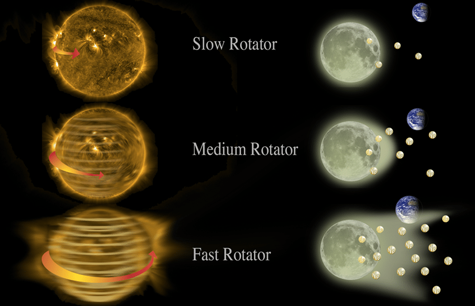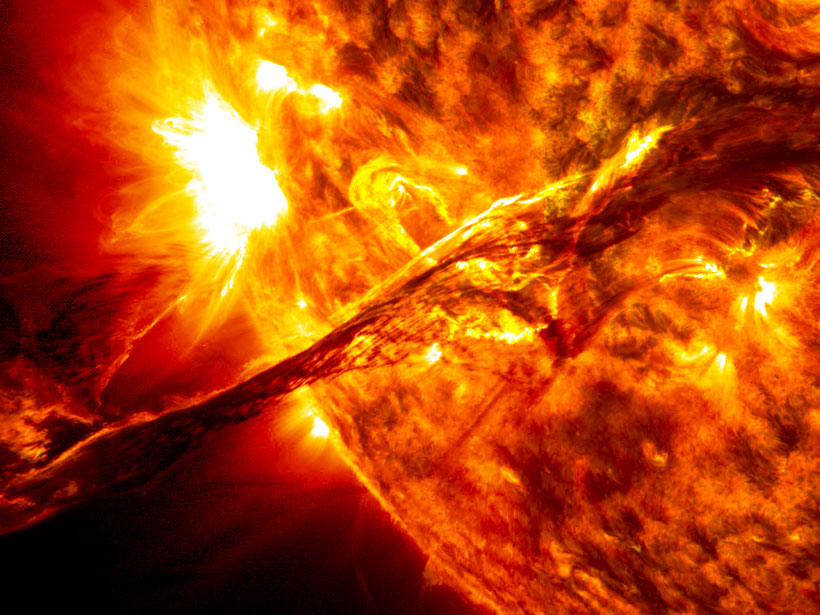During its first billion years of life, the Sun may have been a relatively slowly rotating star, a discovery that may have implications for understanding why life was able to flourish on Earth, as well as increasing understanding of our nearest stellar neighbor.
New research suggests that in the first billion years after it formed, the Sun’s slow rotation could have blasted bombs of charged particles toward Earth and its companion, the Moon, as frequently as every other day. These particles may have led to atmospheric changes that allowed life a chance to gain a foothold.
When clouds of gas and dust collapse to form stars, they start off with a spin imparted by their natal conditions. They slow down over time, making it difficult to determine the speed they were born with.

To find that initial solar spin and its related activity levels, a team of scientists turned their eyes to the Moon.
“Because the Moon had basically no atmosphere for most of its past…it does a really good job of recording history on the surface,” said Prabal Saxena, a researcher at the NASA Goddard Space Flight Center in Maryland. Saxena led a team that studied lunar samples to understand how the Sun behaved in its early life. The results were published in the Astrophysical Journal Letters.
From the Moon to the Sun
The Sun blasts charged particles at orbiting planets every day in the form of the solar wind. Occasionally, it ejects large collections of charged plasma known coronal mass ejections (CMEs). Earth’s atmosphere and magnetic field shield the planet, although some of the radiation still makes it through. But the Moon, with its wispy atmosphere and negligible magnetic field, takes the hits directly on its surface. CMEs have been recorded over the Moon’s 4.5-billion-year lifetime, just short of the Sun’s 4.8 billion years.
As a star rotates, its magnetic field can get twisted up, releasing CMEs from its surface. “The more active the star is, the stronger the wind and the stronger the magnetic field of the star will be,” said Louis Amard of the University of Exeter. Amard, who studies the relationship of a star’s rotation and activity, was not part of the new research.
When the charged particles reach the lunar surface, they bathe the regolith with protons and electrons, changing the chemistry and isotopic signatures of the grains on an elemental scale.
“We can gain a chemical signature of the solar wind at that particular point in time,” said Katherine Joy of the University of Manchester, who was not part of the new study. It can also record the influx of galactic cosmic rays, though to a smaller degree.
“The Moon’s surface could potentially preserve an archive of solar and wider galactic processes.”
“The Moon’s surface could potentially preserve an archive of solar and wider galactic processes,” Joy said.
By studying potassium and sodium in lunar rocks, Saxena and his colleagues determined that in the first half a billion years of their lifetime, the Earth-Moon system was likely hit by an average of one CME every 2 days. The connection to stellar rotation led researchers to conclude that the Sun was likely a relatively slow rotator, though it still spun faster than it does today.
On Earth, those ejections would have lit up the sky with auroras, perhaps as far south as the equator, Saxena said. He said that other independent research has suggested that the rate of CMEs hitting Earth’s atmosphere could have led to changes in chemistry that produced some of the fundamental building blocks for life.
The new data rely on rocks taken from the surface of the Moon, but Joy said that deeper lunar samples could help reveal changes over time by allowing researchers to study lunar rocks that were covered by debris. These rocks would preserve their early chemical signatures.
“What we’d really like to do is access ancient processes,” Joy said. She hopes that future lunar missions might help make that possible. “We need to drill down deep in the moon so we can access those records,” she said.
—Nola Taylor Redd (@NolaTRedd), Freelance Science Journalist
Citation:
Redd, N. T. (2019), Moon sheds light on early solar spin, Eos, 100, https://doi.org/10.1029/2019EO130427. Published on 13 August 2019.
Text © 2019. The authors. CC BY-NC-ND 3.0
Except where otherwise noted, images are subject to copyright. Any reuse without express permission from the copyright owner is prohibited.

